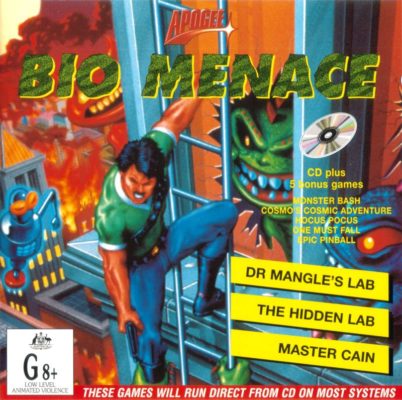A 1993 platform game programmed for DOS by Apogee’s Jim Norwood, who went on to develop Shadow Warriors, Heroes of Might and Magic V, and that cherished classic Third Example Goes Here. You control a porn-mustachio’d spec force operative named (I fear) Snake Logan, who has crash-landed in a mutant-infested city and must etc.
Platform games belong to either the “jump around and collect stars” Mario school or the “shoot guns and blow shit up” Contra school. Bio Menace is unapologetically the latter: it ranks as among the most violent Apogee titles, with monsters dying in explosions of pixelated blood and body parts. This clashes with their visual design, which is “Teletubby crossbred with Barney the Dinosaur”.
Bio Menace looks a lot older than it is. Slated for a 1991 release, it was delayed for two years due to engine modifications, and in 1993 it looked as dated as glam metal. The graphics are 16-color EGA, and the backgrounds don’t parallax-scroll. At least it ran smoothly. I recall being able to play it on Windows XP, although I don’t think it works on any 64-bit operating system.
The game was a competent blend of puzzle-solving (a laser forcefield blocks the way! Can you find the key to disable it?) and hallways filled with monsters to gun down. It had a nice sense of place – the first level in particular is a realistic urban environment littered with bodies and wrecked cars.
Bio Menace tries to create a believable world. Completing levels is just shorthand for “rescuing civilians”. Reaching high places means finding a ladder or riding an elevator, instead of jumping 30 feet. Health powerups and keys are usually found in places that make logical sense, like lockers and cabinets.
This part of Bio Menace hasn’t aged. In fact, it anticipates the future of gaming. The arcades were going away, and the industry was pupating into the next stage of its life: immersive experiences dependent on technology and sensory realism. Bio Menace, with its stupid monsters and EGA pixels, is far from immersive. But playing that first level, with its eerie post-apocalyptic vibe, you can see that the winds are starting to change. For better or worse, games would soon start trying to be movies.
There’s even an effort made at narrative. When you rescue a civilian, Snake Logan has a little tete-a-tete with them, with dialog as amazing as you’d expect (“I’m gonna dust that little dweeb! He can’t do this and escape!”)…hey, at least it’s only the second worst-written videogame about a spec forces operative called Snake, am I right ba-dum tisshhh hurr hurr.
It exemplifies Apogee’s approach: funnel out cheap (and cheaply made) games under a “shareware” business model. You got to play the first 30% of the game for free, and since that 30% typically contained 80% of the game’s actual worthwhile content, this was a pretty good deal. But it did lend itself to disposable experiences, and games that were copy-pastes of some other popular title.
Bio Menace is a minor game, without the arthouse pretensions of Eric Chahi’s Out of this World or the rotoscoped professionalism of Jordan Mechner’s Prince of Persia. It probably made some money, and even if it didn’t, it surely wasn’t a big red stain on Apogee’s balance sheets. Bio Menace is like throwing ten cents down on a roulette spin. Is it worth playing now? No, unless you’re a fan of “ARE YOU A BAD ENOUGH DUDE TO RESCUE THE PRESIDENT?”-style shlock.
No Comments »
Comments are moderated and may take up to 24 hours to appear.
No comments yet.

